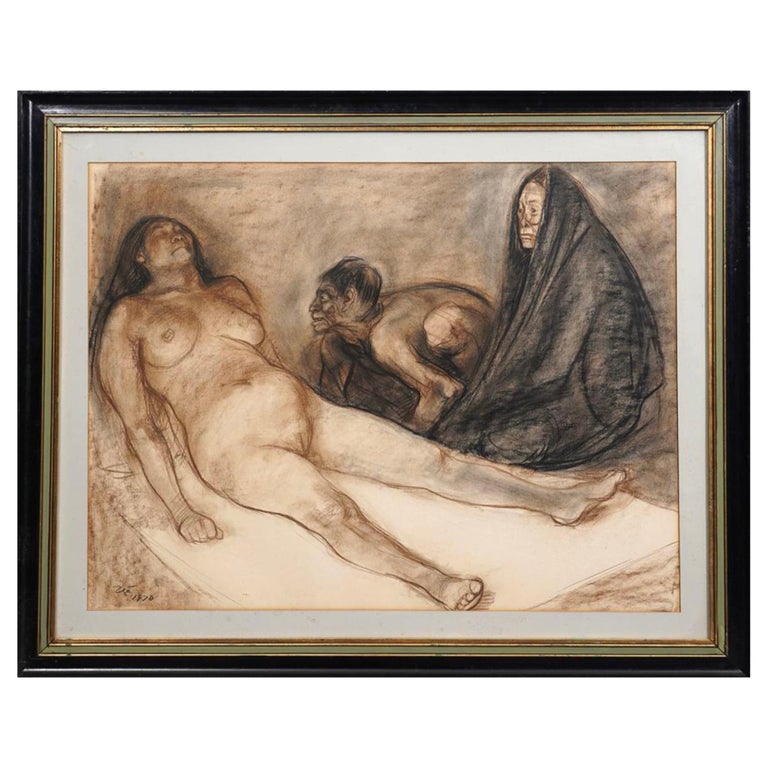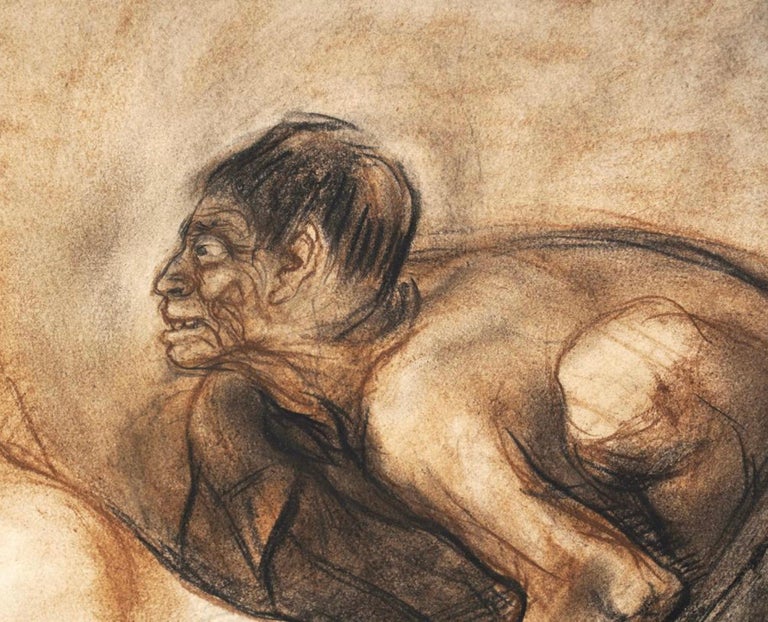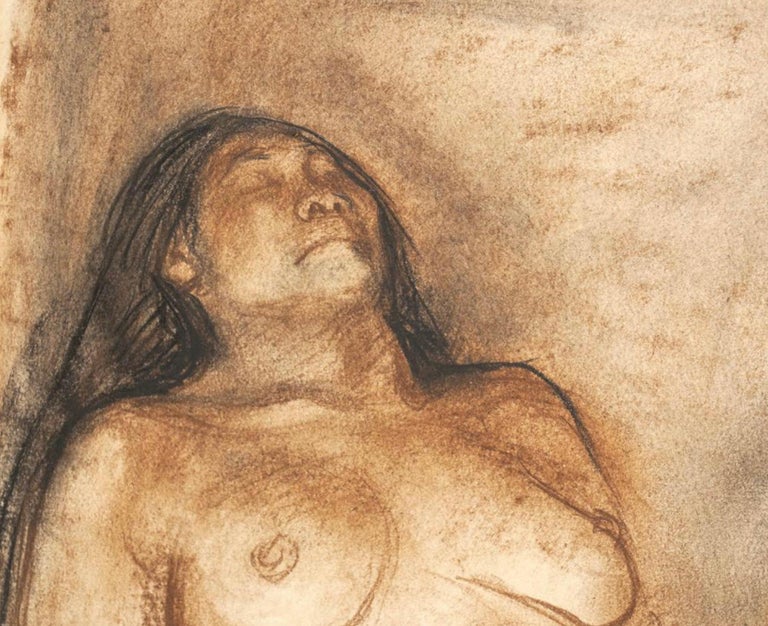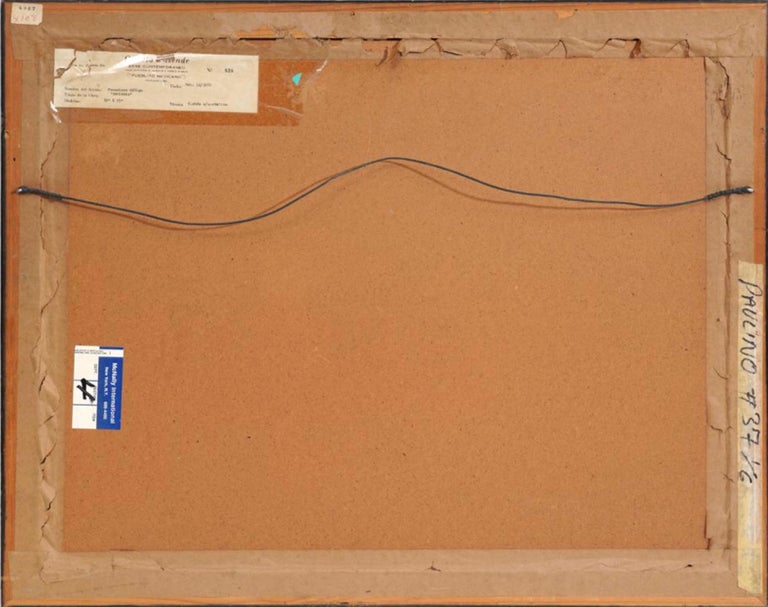Description
Francisco Zuniga, Mexican (1912-1998). ‘Brujeria’, sepia and black charcoal on paper. I spoke with Ariel Zuniga and he was very impressed by this painting saying three or more figures is rare. The scene is of a mother and sick daughter with a witch (Bruja) hovering by her side expelling her maladies. the witch’s eyes are penetrating the daughter at the point of her demise with the mother in black rode mourning the very thought of losing her daughter. A very powerful and moving painting. The color spectrum is impressive combining Sepia and black chalk to create an impressive spectrum of colors and depth in this scene. A COA by Ariel Zuniga will be included with this painting and it will be included in Francisco Zuniga’s upcoming Catalogue Raisonne Vol V.
Signed and dated bottom left 1970.
Ariel Zuniga kindly authenticated this painting through his Zuniga Laborte A.C. Foundation and will include it in the upcoming Catalogue Raisonne Vol V.
Gallery label on verso.
Sight Dimensions: 19 Inches x 25 Inches.
Framed: 25.5″H x 31.5″W.
Condition: painting in very good condition with wear to frame.
AVANTIQUES is dedicated to providing an exclusive curated collection of Fine Arts, Paintings, Bronzes, Asian treasures, Art Glass and Antiques. Our inventory represents time-tested investment quality items with everlasting decorative beauty. We look forward to your business and appreciate any reasonable offers. All of our curated items are vetted and guaranteed authentic and as described. Avantiques only deals in original antiques and never reproductions. We stand behind our treasures with a full money back return policy if the items are not as described.
Biography
Zúñiga was born in Guadalupe, Barrio de San José, Costa Rica on December 27, 1912 to Manuel Maria Zúñiga and María Chavarría, both sculptors. His father worked as a sculptor of religious figures, and in stone work. His artistic inclinations began early and by the age of twelve had already read books on the history of art, artistic anatomy and the life of various Renaissance painters. At age fifteen he began working in his father’s shop. This experience sensitized him to shape and spaces. In 1926 he enrolled in the Escuela de Bellas Artes in Mexico, but left the following year to continue on his own. As part of his self-study, he studied German Expressionism and the writings of Alexander Heilmayer, through which he learned of the work of two French sculptors, Aristide Maillol and Auguste Rodin, coming to appreciate the idea of subordinating technique to expression.
Zúñiga’s painting and sculpting work began receiving recognition in 1929. His first stone sculpture won second prize at the Exposición Nacional de Bellas Artes. In the following two years continued to win top prizes at this event. This work made critics recommend him for study abroad. He won first prize in a 1935 Latin American sculpture competition, the Salón de Escultura en Costa Rica, for his stone sculpture La maternidad,[8] but the work caused controversy and the government rescinded its award. In the 1930s, he began to research pre Hispanic art and its importance to contemporary Latin American art, as well as what was happening artistically in Mexico. The scholarship never materialized so various colleagues organized his first individual exhibition in Costa Rica. The earnings from this endeavor earned his passage to Mexico City. In 1936 he immigrated to Mexico permanently.
In the capital, his first contact with Manuel Rodríguez Lozano, who opened his library to Zúñiga. He did some formal study at La Escuela de Talla Directa, working with Guillermo Ruiz, sculptor Oliverio Martinez, and painter Rodríguez Lozano. In 1937 he worked as an assistant to Oliverio Martínez on the Monument to the Revolution, the re-imagined building that had begun as the Federal Legislative Palace conceived during the regime of Porfirio Díaz. In 1938, he took a faculty position at La Esmeralda; he remained at that position until retiring in 1970. In 1958 he was awarded the first prize in sculpture from the Mexican National Institute of Fine Arts.
In the 1940s, the New York Museum of Modern Art acquired the sculpture Cabeza de niño totonaca and the Metropolitan Museum of Art requested two of his drawings. He also helped to found the Sociedad Mexicana de Escultores and received commissions in various parts of Mexico.
In 1947, he married Elena Laborde, a painting student. They had three children, Ariel, Javier and Marcela.
In 1949, he was part of the founding board of the Salón de la Plástica Mexicana, and in 1951, he joined the Frente Nacional de Artes Plástica of Francisco Goitia .














